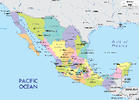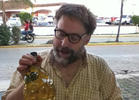
Update: While jokes are flying around the Internet and Twitter about Sinaloa cartel leader Joaquin “El Chapo” Guzman having escaped from the Altiplano maximum security prison in Mexico this past weekend due to self-aggrandizing U.S. personality Donald Trump having recently uttered disparaging comments about Mexico and Guzman, Mexican and U.S. officials are not laughing - at least not publicly.
On July 11, Guzman escaped by climbing through a hole dug in the floor of his prison cell’s shower, then descending 32 feet down a ladder and into a mile-long tunnel five and a half feet high (at 5-foot-5, Guzman is just one inch shorter) which allowed him to walk tall to freedom. Mexican officials have been unable to explain how an estimated 3,250 tons of dirt was dug out of the Earth and removed from the area without anyone at or nearby the prison noticing. Guards regularly patrol outside the prison with radar and other special gear designed to help them detect just this sort of operation, but to no avail.
Arrested by Mexican soldiers back on Feb. 21, 2014, it’s taken Guzman just 16 months to make his latest great escape. U.S officials are claiming they warned the Mexican government more than once of possible plots by Guzman and his people, including a plan by his son and suspected heir to head the Sinaloa Cartel, Ivan Archivaldo Guzman, who was said to have hired ex-military men to aid in an escape. The warnings obviously went unheeded.

Mexican officials were loudly confidant that Guzman’s days as a narco hero and bloodthirsty cartel boss were over, with then Mexican Attorney General Murilllo Karam insisting that the risk of Guzman escaping “did not exist.” This makes the second time Guzman has escaped from a maximum security prison, the first being when he was allegedly wheeled out of Puente Grande prison in 2001, while hiding in a laundry basket.
Vice reports Guzman not only had privileges that other prisoners did not, such as private meetings with visiting family members, and other special treatment while at the Altiplano prison, but that, despite official government claims to the contrary, there was no shut down of the Toluca International Airport, about 25 miles from the prison, after the escape, which might have kept Guzman from boarding a flight out of the area. The apparent ease with which this was designed and carried out without discovery leads many to suspect complicity by guards at the prison, and by unknown others too.
Considering allegations of the DEA and other officials making deals with the Sinaloa cartel that allowed the them to smuggle massive amounts of drugs into the U.S. from 2000 to 2012 in exchange for their help in putting away many of its rivals, it’s not a stretch to think that maybe he had some behind-the-scenes help from shadowy police and/or intelligence types in pulling this off.
This latest escapade is yet another twist in the sordid and extremely violent, yet dramatic and exciting, drug and money-fueled life led by the diminutive “El Chapo” Guzman, who is still going strong. Mexico is offering a $3.8 million reward for info leading to his capture.

Original post: Joaquin “El Chapo” Guzman Loera, leader of the Sinaloa drug cartel, one of Mexico’s most ruthless, violent drug cartels, was arrested on Feb. 21, 2014 at a hotel in Mazatlan, Mexico with not one shot fired. The bloodless operation involved Mexican Marines, with cooperation from U.S. DEA agents. The arrest has been loudly trumpeted by some in the mainstream press as a major victory in the U.S.-led War on Some Drugs. Meanwhile, other press reports, along with current and former members of the law enforcement community, are not so sure how much a victory his arrest really is, nor how much of an impact it will have on curbing drug trafficking and violence in the U.S. and Mexico.
Considering many revelations in the recent past of connections and cooperation between Guzman’s Sinaloa cartel and some agencies within the U.S. government and law enforcement, it should come as no surprise that many are not hopeful his arrest will have any lasting, or even temporary, positive effect. Quite the contrary, they feel it will only lead to an increase in violence as others jockey for position at the head of cartel and control of the ultra-violent, illegal drug trade.
Guzman, founder and leader of the Sinaloa Cartel since 1980, has been on the run since 2001, after his mysterious and daring escape from a Mexican maximum security prison, allegedly fleeing inside a laundry cart. Currently ranked No. 67 by Forbes on their list of the world’s most powerful men since 2009 (his worth is estimated at more than $1 billion), the 56-year-old hefe is also Public Enemy No. 1 in Chicago, the first since the infamous Al Capone in the 1930s. The Chicago Crime Commission alleges up to 80% of the drugs that enter Chicago are supplied by the Sinaloa cartel.

On one side, the U.S. Department of the Treasury has called Guzman “the world’s most powerful drug trafficker.” On the other, Guzman is the subject of numerous narcocorridos (Mexican folk songs lauding various drug criminals), which praise his exploits as a ruthless but magnanimous drug lord. Guzman is seen by many poor and disenfranchised in Mexico as a Robin Hood-like figure, as often happens with generous, colorful criminal types in places where poor people see and experience how idiotic and wasteful the entire War on Some Drugs is, not to mention how criminally corrupt many officers and soldiers are. Guzman’s patronage supplied jobs for many poverty stricken people, fixed their roads and, perhaps counter-intuitively, kept the peace, at least in the community in which he himself lived.
There have long been allegations of shady, behind-the-scenes cooperation between Guzman’s Sinaola Cartel and U.S. law enforcement agencies, with the DEA using Guzman underlings as informants, such as Humberto Loya-Castro, a Mexican lawyer and former advisor to Guzman, himself on the run from law enforcement but allowed to remain free due to his supplying valuable intelligence. Guzman reportedly sent Loya-Castro to speak with Immigration and Customs Enforcement (ICE) officials, basically “duping U.S. agencies into fighting its enemies,” says Prof. Tony Payan of the University of Texas at El Paso. It’s now unclear exactly how much duping was going on, and how much outright working with U.S. officials was happening instead. In January, an investigation by Mexican journal El Universal confirmed there was a deal, from 2000 through at least 2012, struck between U.S. law enforcement (specifically the DEA and ICE) and the Sinalaa cartel, whereby the cartel was allowed to ship drugs through Mexico and into the U.S. with impunity in exchange for information about rival cartels.
These allegations do not paint a pretty picture of U.S. anti-drug, anti-cartel efforts, instead hinting there may very well be ulterior motives for Guzman’s arrest. The DEA would rather those in Congress responsible for allocating the yearly appropriations needed to fund the DEA budget see so-called victories in the Drug War instead of outright collaboration between forces on either side. With last year’s Fast and Furious fiasco coming to light, where the U.S. sold guns to Mexican cartels, guns that were later used to murder a U.S. border patrol agent, it behooves the DEA to show positive results. Yet some former DEA agents have expressed serious doubts about the Guzman arrest, like Phil Jordon, who's surprised Guzman was even arrested considering the amount of money he’s paid to current Mexican Pres. Peña Nieto’s Institutional Revolutionary Party, or Hector Berrellez, who feels the entire thing is a set-up.

“This guy (Guzman) was bigger than Pablo Escobar (the infamous Colombian narco-trafficker whom law enforcers killed in 1993 in a rooftop shootout in Medellin),” Berrellez tells Narco News. “He (Guzman) ran around with a several-hundred man security detail that included Mexican military and federal agents, yet, in the end, he is arrested like a rat in a hole. My sources are telling me it was an arranged thing.”
In a press release following their comments, the DEA stated: "Remarks made by retired Drug Enforcement Administration Agent Phil Jordan and those of other retired DEA agents do not reflect the views of the Drug Enforcement Administration. The arrest of Joaquin ‘El Chapo’ Guzman Loera was a significant achievement for Mexico and a major step forward in our shared fight against transnational organized crime, violence and drug trafficking. We congratulate the Mexican people and their government on the capture of the alleged head of the Sinaloa Cartel. The DEA and Mexico have a strong partnership and we will continue to support Mexico in its efforts to improve security for its citizens and continue to work together to respond to the evolving threats posed by transnational criminal organizations.”
The DEA knows that arresting Guzman and other cartel leaders, while looking good for news cameras and Congressional appropriations committees, will most likely only lead to further bloodshed and corruption as underlings and rivals alike vie for control of the lucrative trade. It will quite likely turn out that whoever takes command will be yet another puppet or pawn of U.S. agencies, illustrating once again how the entire War on Some Drugs is built upon lies, misdirection and propaganda.






